This morning dawned brighter and hotter than ever. Temperatures registered 34
degrees at 10.30am. It has also been very sticky with the feeling that a storm will arrive soon.
Before moving on from our woodland site we decided to wash Modestine down while we had easy access to water and she was under the trees, before the day became too hot. She was completely filthy but she is now clean and respectable again. All this took longer than intended so we did not arrive in Freiberg until nearly lunch time. The town of 50,000 inhabitants is very pleasant indeed with a large cobbled central square surrounded by houses dating from the 16th century. The town is similar to Weimar in many ways and in general we have found the towns of Saxony more full of character than those of Bavaria, in part because for years they have been neglected and are now gradually being sensitively restored. In Bavaria everything is so very smart and clean that the towns look just too perfect.
We had a very ordinary but nice lunch at a bench on the shady side of the pedestrianised shopping area of the old town. It was no more than baked sausages with potatoes and Sauerkraut with a bottle of iced water but it was very nice and very cheap. Later we had coffee in the oldest coffee shop in town at marble topped tables with fresh flowers. We enjoyed our morning in Freiberg despite the heat which really did make it impossible to undertake sight seeing. When we finally dragged our way across the town to the cathedral it was to discover it had just closed for a two hours over lunch time. Not only did Ian miss seeing the famously beautiful pulpit, he had to suffer Jill moaning about the excessive number of cathedrals there seem to be in Europe. Apart from a refuge from the heat their attraction begins to wane when on most days we seem to visit at least one!
 Rathaus, Freiberg
Rathaus, Freiberg We decided to make our way to Meissen rather than Dresden in the hope of finding a campsite where we could leave Modestine and take the train in to Dresden. We also wanted to visit the Meissen porcelain factory which we last saw in a different building back around 1970 when it was a state-run industry. On that occasion we had been staying in Seifennersdorf near the Polish border and we had travelled to Meissen by bus with our Weimar friends Hubert and Sigrid. It had been a long and bumpy journey along roads that were cobbled and pitted the entire distance. We have to say that within the town the streets are not very much better today although the porcelain factory is state of the art.
 Manhole cover - of Meissen men!
Manhole cover - of Meissen men!At the porcelain works we left Modestine in the shadeless car park. There never seems to be any shade here despite the fact that this heat presumably arrives every year. By the time we'd walked the 500 metres back to the entrance we were melting heaps of lard. Please let the porcelain works and museum be air conditioned we prayed. There IS a God! The rest of the afternoon was spent in a cool and wonderful environment gazing at exquisite, delicate porcelain from the 18th century through to today. The same styles though are still being produced so apart from the changes in the crossed swords mark that is the hallmark of genuine Meissen porcelain, the items look exactly the same.
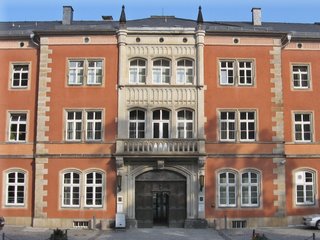 Main entrance of the 1860s porcelain factory, Meissen
Main entrance of the 1860s porcelain factory, Meissen  Meissen porcelain marks
Meissen porcelain marks Porcelain objects used to be imported from China during the 18th century, and later from Japan. In Meissen the Elector August the Strong held an alchemist, Böttger, captive in the castle, originally in the belief that he could turn base metal into gold. What he actually succeeded in doing was to discover how to produce porcelain, a hard, heat resistant ceramic, ideal for serving the hot beverages that had recently become the vogue in Europe. This discovery earned the inventor his freedom and proved to be as rewarding to the Elector as alchemy might have been. The secret of Meissen porcelain made the city rich then and has continued to do so ever since.
When Jill was a small child a very elderly relative used to take her upstairs to her bedroom to see her collection of early porcelain figurines of pretty rural shepherds and shepherdesses, creations of the Meissen factory and generally known as Dresden china. Nan promised that one day they would belong to Jill. In fact this never happened. Today they are not the sort of thing we would welcome anyway but as they were the genuine article, had we inherited them we might have retired considerably earlier than we did! There were many similar items on display in the museum and modern, hand-made ones from the same moulds were selling at astronomical prices.
 Eighteenth century figurine, Meissen
Eighteenth century figurine, Meissen We have several pieces of Meissen that were given to us during the days of the DDR by our Weimar friends. Little can they have realised how such items would increase in value once German reunification arrived. By chance too we have a tiny cup and saucer purchased in Topsham market for £10 a few years ago. We do not know its date but ones manufactured today in the identical style are retailing at 270 euros for a cup and saucer. We wondered about a small tea plate to complete a place setting but that alone was around 90 euros. We didn't buy it.
During the days of the DDR the factory was under state control and there was a period of flirtation with new socialist realist styles. Several of these were on display. We wonder just how great the market would have been for porcelain figures of socialist workers from the 1950s. Maybe there are people who still give these pride of place on their mantelshelves! There were also several attempts to update the styles with tea sets, vases and figurines in art nouveau style, but from 1989 production seems to have been concentrated on reproducing the original styles.
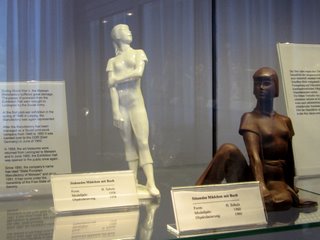 Socialist realism in the 1950s, Meissen
Socialist realism in the 1950s, Meissen The museum also displayed a number of busts of notable personages using a deep red stoneware that no longer seems popular but that we found rather attractive.
 Stoneware bust, Meissen
Stoneware bust, Meissen Tables were laid out with entire porcelain dinner services and the restaurant periodically provides menus served on original Meissen porcelain along with a speaker explaining German table etiquette of the 18th century. At a more affordable price, it was possible to be served hot drinks – tea, coffee or chocolate – in Meissen porcelain cups. Had it been mid-winter it might have been a pleasurable experience but not with temperatures in the thirties.
We were taken through the processes of producing these finished works of art, from the production of the raw material, formed from kaolin, feldspar and quartz, through the moulding, firing, hand painting and any subsequent firings. We include several pictures here which we particularly hope with bring pleasure to our friend Danielle in Guissény. As she is a porcelain painter herself we hope these images will cheer her and give her encouragement for the future.
 Removing the individual pieces of a figurine from the mould. Meissen
Removing the individual pieces of a figurine from the mould. Meissen  Attaching the pieces to make a figurine. Meissen
Attaching the pieces to make a figurine. Meissen  Display of Meissen porcelain showing the different stages involved in underglaze decoration
Display of Meissen porcelain showing the different stages involved in underglaze decoration  Mixing the paints for overglaze decoration, Meissen
Mixing the paints for overglaze decoration, Meissen 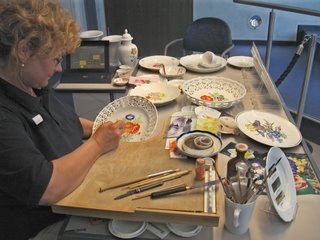 Hand painting for overglaze decoration, Meissen
Hand painting for overglaze decoration, Meissen  Hand painted plates, Meissen
Hand painted plates, Meissen  Nineteenth century coffee set, Meissen
Nineteenth century coffee set, Meissen When we returned into the furnace of the streets we struggled to the town centre where we soaked ourselves in the fountain and sought the shady side of the square to sit consuming ice creams. By now we realised it would be impossible to reach Dresden this evening so sought out a campsite a few kilometres outside of Meissen for the night.
Wednesday 12th July 2006, Coswig, near Meissen, East Germany
It is a year today since Ian finished work. How the time has flown by! For friends still in employment we apologise for saying this, but neither of us has missed work, though Ian has maintained considerable professional interest and contact with former colleagues. Because we have been travelling for most of the past year we have not had time to adjust to retirement yet. This will start when we return home in September when we hope to pick up on the parts of our working lives that interested us, without the routines and frustrations that we so gratefully left behind. We do know just how fortunate we have been to live our dream for a year. No matter what the future holds, we have done what we longed to do for so many years and it has completely lived up to our hopes and expectations.
This morning we woke early because the sun was well and truly up and it was becoming uncomfortably hot in Modestine. Outside there was not a scrap of shade and the glare of the sunlight was dazzling. All we could do was pack up as quickly as we could and move from the site. We were both feeling ill by the time we left. In Spain, Portugal, Italy and Southern France all the sites provided adequate shade with trees and high hedges. Then of course we didn't need them. Here shade does not seem to be taken into account and most sites are now just acres of dry brown earth.
Back in Meissen we found somewhere, still without shade, on the far bank of the river Elbe to leave Modestine. We walked back across the bridge and climbed wearily up to castle and cathedral set so picturesquely on the hilltop, the old town clustering around their feet.
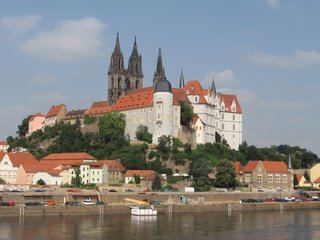 Meissen seen across the river Elbe
Meissen seen across the river Elbe The ramparts of the Albrechtsburg Castle and its interior offered relief from the heat and the glare, as did the cathedral. Both were spectacular and gave us a very pleasant and sheltered morning. The castle was the first in Germany to have been constructed as a residence rather than as a fortification and building work started in 1471. It is painted inside with scenes from the lives of the princes, two brothers, responsible for its construction. The rooms have also been heavily decorated in deep colours with strong vibrant patterns typical of the 19th century. The ceilings of the rooms are all cleverly arched and rib vaulted providing the perfect medium for such elaborate decoration. It was here that Böttger carried out his experiments to create porcelain and the factory was originally established in 1710.
 Painted and decorated main hall, Meissen
Painted and decorated main hall, Meissen  Romantic view of the mediaeval castle, Meissen
Romantic view of the mediaeval castle, MeissenWe parked Modestine today roughly where the king is standing
 Wall painting in the castle showing the alchemist Böttger at work in captivity, Meissen
Wall painting in the castle showing the alchemist Böttger at work in captivity, Meissen Ceiling decoration typical of most rooms in the castle, Meissen
Ceiling decoration typical of most rooms in the castle, MeissenThe Lutheran Cathedral stands within the perimeter of the castle ramparts and is gothic in style. Of particular interest were four statues, dating from around 1250 by the Master of Naumburg. The sculptor's identity is unknown but the Meissen and Naumburg works have been identified as being from the same hand. They are outstanding for their time, expressing a wonderful realism with quite individual features.
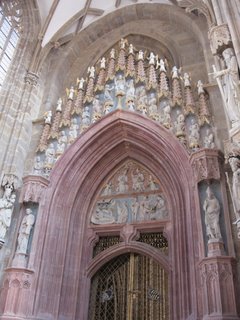 Doorway in the Cathedral, Meissen
Doorway in the Cathedral, Meissen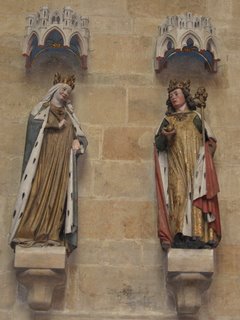 Otto I and his queen by the Master of Naumburg, Meissen
Otto I and his queen by the Master of Naumburg, MeissenNote Queen Adelheid's saucy smile
Also in the cathedral is the original of a painting of Martin Luther by Lucas Cranach the Younger. We saw a copy of this at the Reformed College in Debrecen. Today we waited to take a photo of the original while a Japanese lass had hers taken with the Great Reformer. We wonder if she had the slightest idea who he was! She looked far prettier, healthier and slimmer on her diet of sushi than Luther did on his diet of Worms! (Cringe!)
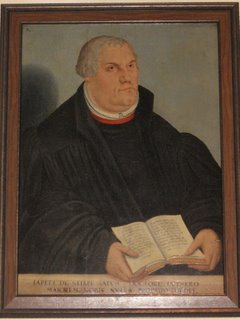 Martin Luther painted by Lucas Cranach the Younger, Meissen
Martin Luther painted by Lucas Cranach the Younger, MeissenWith all this time on our feet we were feeling rather weary and hungry by now so made our way down the steps and cobbled streets to the old town. Here we found a cool internet shop that also served iced fizzy water and spaghetti carbonara. All our needs were satisfied at the same place and we avoided the very worst of the heat until mid-afternoon.
 Roofscape from the castle terrace, Meissen
Roofscape from the castle terrace, Meissen A corner of Meissen
A corner of Meissen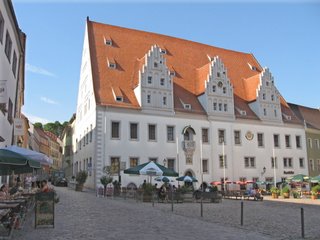 Rathaus, Meissen
Rathaus, Meissen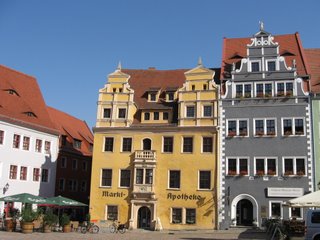 Houses in the market square, Meissen
Houses in the market square, Meissen Market square with Frauenkirche, Meissen
Market square with Frauenkirche, MeissenThe church has a porcelain glockenspiel. We found its tone delightful
Wonderful as we have found Meissen, we felt we had seen as much as we were able to take in the heat so struggled back to Modestine and drove along beside the river Elbe towards Dresden searching for a campsite that offered more shade than last night's did. We are now staying beside a lake under a rather small chestnut tree. We just hope it will provide sufficient cover tomorrow morning. This afternoon it has saved our sanity. So has the lake. Even Ian could not wait to get into the water despite the crowds of families crowded round the edge on one side and the nudists stretched out in the sunshine on the other! We have been pleased to discover we get free entry as we are staying on the campsite. We have been told we can cycle to the railway station and take a train to Dresden, so Modestine can have a free day tomorrow.
This evening we have finished off our Czech wine and the bottle of Chinese beer. Neither were very nice but at least they were cold. We have to turn off our fridge when we disconnect the electricity each morning but despite the hot weather it is so well insulated the freezer block is still solid when we hook up again in the evening. There is no end to the wonders of Modestine! As we write this evening thunder is rumbling around, the air is close and a few drops of heavy rain have done their best to drive us inside with our computer. Rain may return during the night. Extrovert, noisy, irritating and persistent as he is when he's around, after a few days we find we really miss him and long for his return.
Thursday 13th July 2006, Coswig, near Meissen, East Germany
At 5.30am we woke with the sun streaming fiercely through Modestine's open window. As further sleep was impossible we were soon up, trying to make the most of the day before it became unbearable. It is Ian's birthday and one of the things he has always longed to do is to see at close hand the Maya codex held in the University Library in Dresden. So by 8.30am we had cycled to the railway station a few kilometres away and leaving Hinge and Bracket chained to the railings we were on our way into Dresden.
 It's amazing how often you find one when you look! Dresden
It's amazing how often you find one when you look! DresdenWe last visited this city over thirty years ago with Hubert and Sigrid when Germany was still divided. At that time it was suffering from the aftermath of Allied bombing when the town was almost totally destroyed and 50,000 people lost their lives. We remember Hubert's elderly aunt, long since dead, telling us of the terror of the night of 13th February 1945 when the bombs fell and the town was a tornado of fire. People rushed into the main park, hoping to avoid the flames, only to find themselves attacked by frantic animals which had escaped from the zoo. At that time it was the greatest air attack ever to have been perpetrated on a civilian population, predating Hiroshima by several months. Why the raids took place is unclear as Germany was well on the way to defeat at this stage in the war.
 Taking tea from Meissen porcelain in Dresden with Tante Mariechen. A photo taken in 1972
Taking tea from Meissen porcelain in Dresden with Tante Mariechen. A photo taken in 1972The day after the raids, with devastation all around, the beautiful Frauenkirche was still standing, complete and intact amidst the bombed and burned out buildings. On the 15th February, we were told, a service took place in the church giving thanks for its survival. Just as the worshippers had left, the building simply collapsed in ruins. When we were last here we saw this awesome sight, standing alone in a vast wasteland of weeds and rubble. It was intended to remain like that as a memorial to those who had lost their lives on that fateful night.
However, since reunification it has been decided to return the church to its former splendour. Now it stands in the centre of a huge paved area, complete and beautiful. Many of the original blackened, fire damaged stones have been reused and are scattered amongst the new paler stone. Inside it is quite beautiful. It seemed so strange to go inside a magnificent church that we had last seen as a shattered and burned-out shell.
 Rebuilt Frauenkirch, Dresden
Rebuilt Frauenkirch, Dresden Interior of the rebuilt Frauenkirch restored to its original glory, Dresden
Interior of the rebuilt Frauenkirch restored to its original glory, DresdenOn arriving in town this morning we made our way to the University of Dresden, a short tram ride outside the town centre. Here there are still wide open spaces where buildings once stood. Amidst this grassland stands the University and its library. Upstairs we discovered the air conditioned book museum with a special collection of Napoleonic cartoons together with prints and books on the life of Napoleon's minister the Marquis de Talleyrand. It was worth the visit for this exhibition alone, especially as some years ago Ian was responsible for an exhibition of Napoleonic cartoons from the collections of Exeter Library which was also displayed in Caen. Several of the caricatures by Gillray, Cruikshank and Rowlandson which had featured in that exhibition were also here, together with many other fascinating exhibits relating to Talleyrand's long and eventful career.
 Napoleonic caricature displayed in the University Library, Dresden
Napoleonic caricature displayed in the University Library, DresdenThe rare books strong room was unlocked for us and there the famous Maya codex was displayed in its entirety. It is the most complete of its kind in the world and one of only three that survive in legible form. Produced around 1250 it was purchased for the Ducal Library as a Mexican book in 1739 but it was not until 1853 that it was properly recognised for what it was.
 Maya codex in the Book Museum of the University Library, Dresden
Maya codex in the Book Museum of the University Library, DresdenThe lighting was subdued and we could not use flash
There were a number of other notable items on display. These included a copy of the Mainz Psalter, printed in colour by Fust and Schoeffer in 1457, a collection of beautiful matching bindings from the ducal library dated 1556, the original manuscript scores of compositions by Weber, Vivaldi, Bach and Schumann, a collection of lectures in the hand of Martin Luther and an illustrated manuscript of Albrecht Dürer's work on the proportions of the human body.
All in all a pretty good way for someone like Ian to spend his birthday! Later he enjoyed a coffee and sticky bun in the students' refectory before we were obliged to face the heat of the morning where the sun seemed to scorch your very eyeballs as we waited for the tram to take us back into town.
Here was another surprise. On our last visit there was a huge area laid out with a series of long ponds and fountains in what was intended to become a major new socialist shopping complex and housing development. Other than the water features there had been nothing to see. Now it stands at the heart of a major pedestrianised shopping complex with bars and cafés integrated with all the major retail companies from Macdonalds to C&A. There are also large blocks of flats dating from socialist times that do not exist on our old colour slides back home.
 Modern shopping precinct developed around the futuristic water feature of the early 1970s, Dresden
Modern shopping precinct developed around the futuristic water feature of the early 1970s, Dresden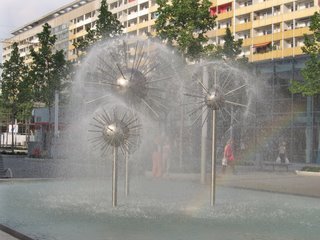 Water feature and socialist housing built during the early 1970s, Dresden
Water feature and socialist housing built during the early 1970s, Dresden Fortunately some features of socialist times have been recognised as having certain artistic merit, Dresden
Fortunately some features of socialist times have been recognised as having certain artistic merit, DresdenThe city is celebrating its 800th anniversary and there are commemorative horses scattered around the town in recognition of this. Because of its tragic past however the town has little original history to celebrate. There are the wonderful reconstructed jewels obviously, but generally it seems a city of building sites, shadeless wide open spaces with temporary concert stands, wooden shacks and advertisement hoardings.
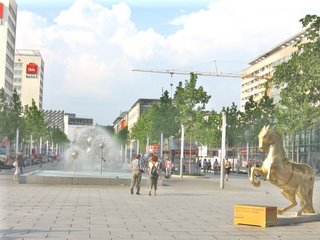 One of the many horses to be found around the city centre, Dresden
One of the many horses to be found around the city centre, Dresden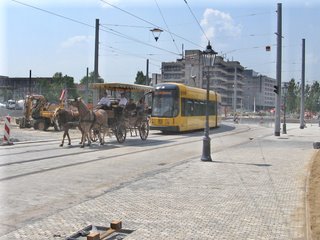 Horse-drawn traffic holds up a tram in one of the many wide open spaces, Dresden
Horse-drawn traffic holds up a tram in one of the many wide open spaces, Dresden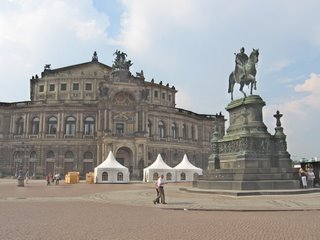 Theater Platz with the Opera House and transitory tents, Dresden
Theater Platz with the Opera House and transitory tents, Dresden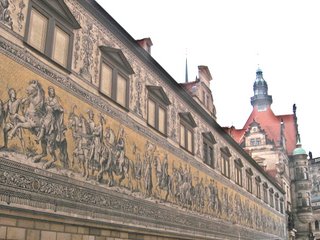 Historical frieze of 24,000 Meissen tiles on the external castle wall, Dresden
Historical frieze of 24,000 Meissen tiles on the external castle wall, DresdenBecause of the temperature it was impossible to enjoy time exploring the city as we would have liked. So we concentrated on the second main reason for coming to Dresden which was to see the art treasures in the incredible Zwinger, a wonderful series of baroque pavilions which now house a series of major museums. During the war these treasures were fortunately hidden away and therefore survived the bombings. Immediately after however, their location was discovered by Russia and everything was taken back to Moscow, allegedly for "safe keeping". It is a matter of surprise that Russia actually returned all these treasures to the Zwinger as a gesture of Soviet friendship back in the late 1950s, once the largely destroyed complex had been rebuilt to its original design and was in a position to display the items again.
 Zwinger with arcades and Kronentor, Dresden
Zwinger with arcades and Kronentor, Dresden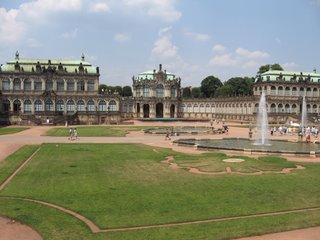 General view of the Zwinger and its courtyard, Dresden
General view of the Zwinger and its courtyard, Dresden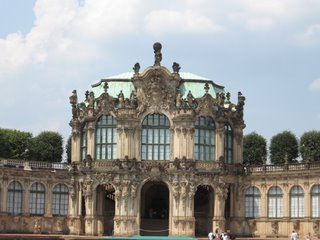 Zwinger showing the Wallpavillon, Dresden
Zwinger showing the Wallpavillon, Dresden Jill makes friends with one of the residents, Zwinger, Dresden
Jill makes friends with one of the residents, Zwinger, DresdenWe have been on our feet all day and feel exhausted, but at least the Zwinger was generally cool by contrast to the heat outside. While we were inside there was a thunder storm with heavy rain but by the time we came out the heat had largely evaporated the wet and the atmosphere was more moisture-laden, hot and clammy than ever.
There are just so many wonderful and famous painting on display that the brain ceases to marvel after a while. To name a few, there were works by Dutch and Flemish artists Rembrandt, Vermeer, Breugel, Van Dyke and Ruysdael. There were several paintings by Nicholas Poussin. There were masterpieces by Botticelli, Andrea del Sarto and Raffael, Mantegna, Titian and Canaletto,. There were works by Goya, Murillo, the Cranachs and countless other famous painters. They are now just a blur but at the time it was a magic experience to sit in the centre of a huge room and gaze at famous paintings on the walls around us.
It was after 4pm by the time we eventually emerged and the day was still far too hot and bright for comfort. We made our way slowly back to the Hauptbahnhof and the train to Coswig where we picked up our bikes. Back at the campsite Jill went for a swim in the lake and despite the threat of a thunderstorm we were able to enjoy a celebratory supper by candlelight that included wine and chocolate cake in the gloom of the evening outside of Modestine. There were messages left on our mobile from Neil and Jeev, Kate and Joe, an internet card from Ian's sister Jill. There was also an unusual card in our email. All in all Ian seems to have had a very happy birthday.
 Happy birthday to Ian, Coswig near Dresden
Happy birthday to Ian, Coswig near Dresden Happy birthday Dad from Neil and Jeev
Happy birthday Dad from Neil and Jeev